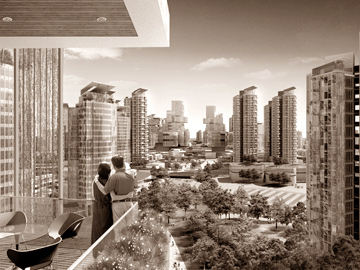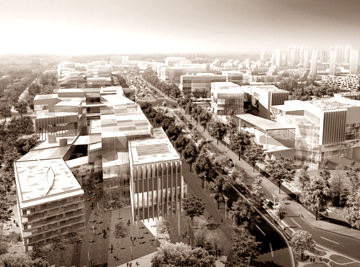|
Eco cities:
Moving towards sustainable urbanism
by Patali CHAMPIKA RANAWAKA
|

Artists’ impressions of eco cities
|
In February 2008, I participated in a special United Nations meeting
on Climate Change, presided over by its Secretary General Ban Ki-moon.
As an informal side event to this meeting, he hosted a dinner for the
high level delegates, preceded by a round table conference.
The conference was held on the rooftop of the UN Secretariat
building, which provided a panoramic view of the city of New York. The
rooftop had a magnificent view of well-illuminated skyscrapers,
buildings of various geometric designs, a network of highways, waterways
with sailing vessels and planes and helicopters flying over the
skyscrapers with blinking lights. All that one could see from the
rooftop of the UN building that evening was nothing, but the marvels of
engineering and achievements of the modern generation.
The theme of the conference was ‘Global warming’ at which almost all
the Heads of State and the Ministers of Environment expressed their
concern over the prevailing situation. At the conference, a few
speakers, including the UN Secretary General went to the extent of
suggesting that some concrete action be taken to mitigate the problem
before the climate change COP meeting scheduled to be held in December
2009 in Pozan, Poland. However, the Director General of the United
Nations Environmental Program (UNEP), Achim Steiner was trying to strike
an optimistic chord; he was of the view, that evolving knowledge and
technology would solve the problem, and to promote this argument, he
emphasised on carbon-captured techniques, clean coal and promoting green
technologies like renewable energies and the concept of sustainable
cities.
I was not convinced by the submission of the UNEP Director General.
When I was given the floor, I invited them to look through the giant
glazed windows and posed them a simple question. “Can the people of the
United States be able to sustain these colourful giant structures in the
absence of fossil fuels? It is a fact that the world’s resources will be
exhausted within another five decades. Even if we assume that there is
infinite reserves of fossil fuels, we know that its burning results in
heat pollution. Will not the very existence of mankind be threatened by
environmental catastrophes, so created by heat pollution? So what does
this mean? Are we to abandon these man-made colourful forests of
concrete, steel and glass? Does that mean man-made modern jumbo ships,
planes and vehicles would be made extinct like dinosaurs? Will not that
eventually make New York - the world capital, as many people believe - a
modern day Jurassic Park?”
Although most of the delegates stopped short of agreeing with me,
they privately shared my views and said that New York and similar
concrete jungles were not sustainable and were doomed. The solution is
building sustainable cities, green buildings, zero emission vehicles,
eco-corridors and such to absorb human pressure.
What is an eco or green city? Could we be able to create sustainable
urbanism, urban design with nature? Whatever the definition may be, we
must achieve these ideals during the 21st century. Otherwise, the
scarcity of fossil fuels coupled with global warming would create an
irreparable, huge fracture on the tutonic plates of the earth. In its
simplest definition, a green city is carbon neutral and is fully
sustainable.
 Economist Matthew Kahan once wrote that a green city is a healthy
place that has clean air and water, pleasant streets and parks and is
resilient to natural disasters, though subject to a few risks of
infectious diseases. Economist Matthew Kahan once wrote that a green city is a healthy
place that has clean air and water, pleasant streets and parks and is
resilient to natural disasters, though subject to a few risks of
infectious diseases.
Its residents have strong green behavioral habits like using the
public transit, practising recycling and water conservation using
renewable energy (Kahan 2006).
That means green cities and their inhabitants would use to the
maximum their allotted natural environment to sustain human life. They
should use energy from the sun and the resources from the earth so that
its vegetation too could supply, use and reuse the basic necessities.
Most of the energy, minerals and other resources have already been
consumed by our modern cities. Modern development is creating more and
more unsustainable cities.
On the other hand, cities are places where the market and money are
created and a place where wealth is accumulated. Modern cities are built
environments for market and wealth, so it is fundamentally related to
the economic and financial spheres as well. Therefore creating
sustainable urbanism and building greener cities would be the
cornerstone of the new paradigm, sustainable paradigm and green economy.
Then the problem arises as to how we could achieve this urban
sustainability. The first principle should be, if and when we were to
build a new city or an urban centre, we should adopt green models.
So, with regard to the North and East development, we could use green
principles to build new cities and urban centres.
The second principle is the transformation of existing cities and
urban centres into green cities for their vital success. This
transformation needs a step-by-step approach and public awareness and
agreement.The first step towards sustainable urbanism is providing a
market for it and this comprises several facets. One is its legal frame.
We should amend the existing bylaws and statutes of the local government
system so that they should adhere to the green law principles.
Implementing such laws definitely creates new markets. For instance,new
laws on garbage disposal may create new green business. We should also
introduce a set of green codes for the environmental impact evaluation
of buildings and infrastructure.
That means, we should introduce a set of guidelines for constructing
any structure with the appropriate yardsticks to measure their
greenness. Also, introducing green building codes and implementing them
seriously with the vested authorities should be of paramount importance.
In my opinion, the Urban Development Authority and Central
Environmental Authority should jointly impose these codes so that a new
green market could be created in the construction industry as well.
The second step would be dismantling fossil fuel barriers to
sustainable urbanism. In modern cities, most of the energy comes from
fossil fuel, they are being used in transportation and the controlling
of temperatures in building through heating and air-conditioning.
Therefore, zoning, siting and proper landscaping could reduce energy
usage. Urbanised zoning plays a key role in designing sustainable
cities.
These zones should be identified as industrial, commercial,
residential, administrative, recreation, environmentally sensitive and
waste management areas, and the relevant zoning laws should be strictly
implemented. The siting of buildings is also important as it
significantly reduces the cost of transportation. The designing of a
proper road network and creating eco-corridors to act as a carbon sink
would be another aspect of proper siting of buildings. By using green
architecture, one can reduce the resource usage and maintenance cost of
buildings.Buildings with energy auditing, zero emission or those with
the capability of generating recycled energy complement every
fundamental of green architecture. Encouraging public or mass
transportation using hiring services, using zero emission vehicles or
hybrid vehicles for transportation, creating walkways and bicycle tracks
and interlinked road networks would make transportation a sustainable
process.
The most sensitive factor in the zoning process is to identify
environmentally sensitive areas. Water conservation and green air would
reduce public healthcare costs and will benefit all living beings.
The third step is the national campaign for implementation of
sustainable urbanism. There are a few challenges in communicating these
concepts. The most difficult is to convince the public to recognise the
importance of sustainable urbanism. In general, many people lack the
knowledge about how cities and structures affect their health and
quality of life. Cities generally compartmentalise and alienate families
and individuals from their dwellings, their lives and our world.
The public should be made aware of the limitation of fossil fuel as
an energy source and its impact on climate change related disasters.
Although convincing the public and political authorities about how
they could avert disasters and benefit from green cities would be most
difficult, it is a worthy exercise that has to be embarked upon.
A new cultural pattern has to be evolved, based on the principles of
sustainable urbanism for the sake of future generations.
(The writer is the Minister of Environment and Natural Resources)
|

